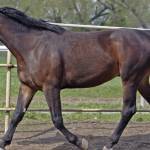Evaluation of a Forage-Only Diet for Young Horses in Training

Concentrates or grains are a common part of the diet for young horses that are being trained for racing or other disciplines. These products supply energy, protein, and a range of nutrients that are needed to support the demands of exercise. However, grain contains a high level of carbohydrate that has been linked to an increased risk for laminitis, colic, hindgut acidosis, gastric ulcers, tying-up, and various other metabolic muscle disorders. The question for an owner or trainer is how to provide enough energy for growth and exercise without inviting grain-related problems.
A recent study led by Anna Jansson, Ph.D., a professor at the Swedish University of Agricultural Sciences, tested the idea that a diet of high-energy, high-quality forage without added grain could be the answer. The research team used 16 American Standardbred colts in the study. From August to December, the colts were fed a diet of free-choice grass haylage, a mineral supplement, and a pelleted alfalfa (lucerne) product.
Growth, response to training, and health were monitored as the colts progressed through race training. Work intensity and number of sessions were recorded daily as the training progressed. Feed intake and physical development were documented monthly. Body length, weight, height at withers and croup, cannon bone circumference, hoof and coronet dimensions, and thickness of back muscling and rump fat were measured during the early training period as the colts learned to trot on the racetrack while pulling a cart.
Standardized exercise tests were performed in October and December, and heart rate was measured for each horse during the test. In December, venous blood samples were collected after exercise and analyzed for plasma lactate concentration. Muscle biopsies were also taken and were analyzed for glycogen and fiber composition.
The horses remained on the same diet for the next two years as they continued training and began racing. The research team continued to track the horses’ progress and an independent veterinarian evaluated the horses twice, reporting good health and normal growth rates for all the colts. The horses were also found to have muscle glycogen levels within the normal range. They lost few training days for health reasons, and met the goal of the study, which was to be able to trot 5 to 7 km at a speed of 5.6 m/s (3 min/km). It was concluded that yearlings in training fed high-energy forage ad libitum can reach a conventional training goal and grow at least as well as yearlings of other light breeds.








